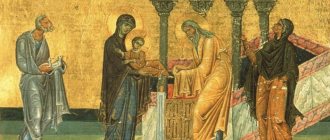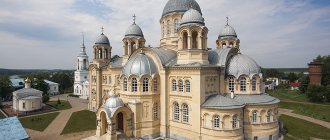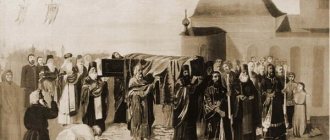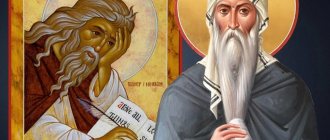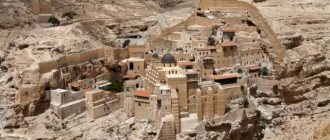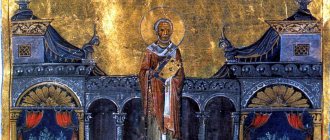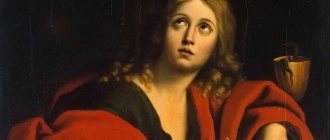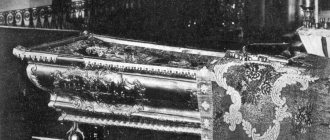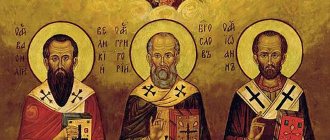| St. Simeon the New Theologian, Greek icon. |
Simeon the New Theologian
(946 - 1022), abbot, venerable Memory March 12 and October 12 (Greek [1])
Born in 946 in the city of Galata (Paphlagonia) and received a thorough secular education in Constantinople. His father prepared him for a court career, and for some time the young man occupied a high position at the imperial court. But having reached the age of 25, he felt an attraction to monastic life, fled from home and retired to the Studite monastery, where he underwent obedience under the guidance of the then famous elder Simeon the Reverent.
Studite Monastery
The main feat of the saint was the incessant Jesus Prayer in its short form: “Lord, have mercy!” For greater prayerful concentration, he constantly sought solitude, even during the liturgy he stood separately from the brethren, and often remained alone at night in church; To get used to remembering death, he spent nights in the cemetery. The fruit of his zeal was a special state of admiration: during these hours the Holy Spirit in the form of a luminous cloud descended on him and covered everything around him from his eyes. Over time, he achieved constant high spiritual enlightenment, which was especially evident when he served the Liturgy.
Monastery of St. Mamant
Around 980, the Monk Simeon was made abbot of the monastery of the holy martyr Mamant. He was ordained to the rank of presbyter by Patriarch Nicholas II of Constantinople.
St. Simeon put the neglected economy of the monastery in order and landscaped the temple in it.
The Monk Simeon combined kindness with severity and strict observance of the Gospel commandments. So, for example, when his favorite student Arseny killed the crows that had eaten soaked bread, the abbot forced him to string the dead birds on a rope, put this “necklace” around his neck and stand in the yard. In the monastery of St. Mamant, a certain bishop from Rome, who accidentally killed his young nephew, atone for the sin, and the Monk Simeon invariably showed kindness and attention to him.
The strict monastic discipline, which the monk constantly instilled, led to strong discontent among the monastic brethren. One day after the liturgy, particularly irritated brothers attacked him and almost killed him. When the Patriarch of Constantinople expelled them from the monastery and wanted to hand them over to the city authorities, the monk begged forgiveness for them and helped them in their lives in the world.
Around 1005, the Monk Simeon handed over the abbess to Arseny, and he himself settled at the monastery in retirement.
Exile and foundation of the monastery of St. Marina
The Monk Simeon annually celebrated the memory of his mentor Simeon the Reverent, composed words of praise, songs and canons in his honor, and painted his icon. Patriarch Sergius the Manuilite, having heard about this, approved of Simeon, but Metropolitan Stephen of Nicomedia, and with him some of the parish priests and laity, rebelled against this custom, finding it contrary to the order of the church and tempting [2].
To calm minds and satisfy Stephen, the Patriarch and the Synod decided to remove Simeon from Constantinople. He retired to the shores of the Bosphorus and to the area belonging to his student and admirer, the patrician Christopher Fagur. Here the Reverend established a monastery for St. Marina, lived in it for 13 years and died peacefully in 1022 [3].
During his lifetime he received the gift of miracles. Numerous miracles were performed even after his death; one of them is the miraculous acquisition of his image. His life was written by his cell attendant and disciple, the Monk Nikita Stifat.
| St. Simeon the New Theologian, icon |
Saint Simeon the New Theologian - monk, theologian, poet
Simeon the New Theologian is a monk, theologian, and writer of poetic spiritual verses called “Hymns.” He is one of the most prominent representatives of the tradition of hesychasm, that is, the Christian mystical worldview, an ancient spiritual practice that forms the basis of Orthodox asceticism.
For his wisdom, he received the name New Theologian, along with two other great theologians of the Christian Church - John the Theologian and Gregory the Theologian. He is revered by the Orthodox Church in the person of St.
Venerable Simeon the New Theologian. Icon. Reverend Simeon the New Theologian is a monk, theologian, and writer of poetic spiritual verses
Saint Simeon was born in 946 into a wealthy family of provincial nobles in the city of Galatea, Paphlogia (Asia Minor). His parents wanted to give him a good education and at the age of eleven they sent him to study in Constantinople.
The saint's father wanted to send him, upon completion of his studies, to the imperial state service.
946
Saint Simeon the New Theologian was born this year
Despite his father's wishes, Simeon did not at all want to become a brilliant courtier. From childhood he sought to serve God. Fulfilling his desire at the age of 25, he ran away from home without even receiving a secondary education.
He escaped together with an elderly monk from the Studite monastery. His name was also Simeon.
Venerable Simeon the New Theologian, Greek icon. It is believed that Saint Simeon initially lost interest in monastic life after he saw the Divine Light in a vision
The saint had a vision during night prayer. It is believed that Divine light appeared to him. After this appearance Simeon grew cold and decided to return to worldly life. For several years he lived like this, avoiding sinful actions and deeds through the prayers of the elder.
At the same time, he kept thinking about how to move away from the world, despite his spiritual cooling.
Scripture
Scripture, according to Simeon, is part of tradition. Scripture is not the basis of religious faith, it is itself based on and reflects religious experience.
“Only that reading is useful which is accompanied by the implementation of what is read,” writes Saint Simeon.
“While reading, you need to look into yourself, examining and studying your soul as in a mirror,” he teaches.
The Bible is a message addressed directly and personally to each reader. The Holy Fathers believed in the living presence of Christ in Scripture.
Gregory of Nyssa writes that the main reason for crying over sins is the falling away from good, which is the Lord Himself.
Saint Simeon deeply comprehends the meaning of Scripture and writes deeply about it.
Those who hunger for righteousness are those who hunger for the Lord, says Saint Simeon. The merciful are not those who give money to the unfortunate and poor. Charity is not individual acts of charity, but an internal quality of a person, which is acquired by feat.
An idle word is not fulfilling the commandment to speak about it. Scripture is a means to help us live with God and in God.
Saint Simeon the New Theologian is considered a Christian mystic
Due to the fact that the Monk Simeon the New Theologian always adhered to the ideas about the possibility and necessity of feeling the presence of God even at the early stages of asceticism, he is considered a Christian mystic.
Naturally, the understanding of this term is oral. Believing that Christ gives grace to all those who seek the path of unity with Him, the saint tried to convey his experience of meeting with Him not only to the brethren, but also to the widest possible circle of people.
1005
this year Saint Simeon transferred the abbess to Arseny after the indignation of the monks of the Studio monastery
The abbot gained great popularity and people from different places began to come to him. At the same time, he introduced strict monastic discipline into the monastery. After 15 years had passed since his appearance in the monastery, some of the monks, dissatisfied with the strict regulations of the abbot, staged an indignation.
One day, during the liturgy, the instigators of the riot rushed at the abbot. The life of the saint says that the grace of God that dwelt in him as a saint helped him to hold back and throw away the wicked.
Saint Simeon the New Theologian. Icon. In all the monasteries where the Monk Simeon resided as abbot, he introduced strict rules
Troublemakers ran out of the church and broke down the doors of the monastery. After that they ran to the Patriarchate. Having told the Patriarch of Constantinople Sisinnius their complaints, they began to ask him for support.
The Patriarch, having understood their essence, ordered them to be expelled from the monastery and wanted to hand them over to the city authorities. Saint Simeon begged forgiveness for them from him and later helped them in their worldly life. Around 1005, the Monk Simeon handed over the abbess to Arseny, and he himself settled at the monastery in retirement.
Prayers
Troparion, tone 3
Divine illumination, Father Simeon, / having received in your soul, / you have appeared as the brightest luminary in the world, / dispelling that obscurantism / and assuring everyone to seek, even after destroying, the grace of the Spirit, / diligently pray for Him // to grant us great mercy
.
Troparion, tone 1
You were not involved in external wisdom, / but you were filled with the Divine, / and the New Theologian was truly known by everyone, Simeon. / For this sake of your memory, wise father, we cry out to you: / glory to Christ who glorified you, / glory to Him who showed you wondrously, // glory to Him who heals you all
.
Troparion, tone 4
As a spectator of the Trisolar Light / and a teller of the mysterious Theology, / blessed Simeon, our Father, / ask for enlightenment for our souls from above / and drive away the darkness of passions from us, / for, as a great servant of Christ, // you give useful things to everyone, reverend
.
Kontakion, tone 3
Enlightened by the Trisolar Light, O God-Wise One, / Thou art the Theologian of the Divine Trinity. / Having been enriched from above with the wisdom of words, / you have exuded Divine streams of God-wisdom, / drinking from them, we cry: // Rejoice, blessed Simeon, taught by God
.
In Kontakion, voice 2
(Similar to: Thy blood)
As the Most Divine Theologian of God / and our great prayer book to the Lord, / everlastingly, Simeon, pray to grant us forgiveness of sins // and correction of life, reverend
.
Before his death, the Monk Simeon the New Theologian founded a new monastery
The Monk Simeon the New Theologian experienced feelings of strong affection for his spiritual father Simeon the Reverent. That is why he annually celebrated his memory, wrote words of praise, songs and canons in his honor, as well as his icon.
Patriarch Sergius Manulit approved the saint’s act, but Metropolitan Stephen of Nicomedia and some of the parish priests and laity rebelled against such a custom. They found it contrary to church order and also seductive.
Residence of the Patriarchs of Constantinople in Constantinople (Istanbul). Engraving. 1737. In 1009, Patriarch Sergius Manulitus of Constantinople decided to remove St. Simeon the New Theologian from Constantinople.
In order to calm the minds of the brethren and satisfy Stephen, the Patriarch, together with the Synod, decided to remove Simeon from Constantinople. This happened before the beginning of 1009.
The saint retired to the banks of the Bosophorus, to the area that belonged to his disciple and admirer, the patrician by birth, Christopher Fagur. Here the Patriarch transferred to the management of Saint Simeon the prayer house of Saint Mary, on the basis of which he later created the monastery of Saint Mary.
The Monk Simeon the New Theologian lived in the monastery of St. Mary for 13 years. Here he wrote most of his Hymns. In 1022, he died peacefully in the monastery from a stomach illness.
Even during the life of the saint, it became known that he received from God the gift of miracles. For example, after his death, an icon of the saint was miraculously found. In Orthodoxy, the saint is commemorated on March 12 (25).
Divine service
Simeon considered worship a school of prayer and spiritual life. Communion turns our whole life into Easter.
The idea of the sanctification of reality was originally a fundamental principle of the seventh and annual liturgical circles.
Church holidays are for the benefit of the soul and for inspiration to a virtuous life.
The mystical life of a Christian is impossible without worship.
Since the 8th century, monasteries became missionary and educational centers in cities - many city monasteries appeared. They also provided spiritual guidance to the Laiks. The daily revelation of thoughts already exists in the earliest monasticism.
“Know, child, that God does not rejoice in fasting, vigil, physical labor, or any other right deed, but only appears to a humble, incurious, kind soul and heart,” writes Saint Simeon the Reverent.
Removal from the world, according to St. John Climacus, is a struggle with passions and the mortification of one’s will.
“Every good deed should be performed with humility,” teaches Saint Simeon the Reverent.
“Words” and “Hymns” are the most famous works of St. Simeon the New Theologian
In theology, St. Simeon the New Theologian is known primarily as a theologian and preacher, and a distinctive feature of his theology is the application of theoretical Christian teaching to Christian life.
Unfortunately, the saint's works have been published in Slavic and Russian in very limited quantities. So, for example, in the “Philokalia” (a book of Orthodox spiritual writings printed: “Active and theological chapters” (numbering 152; in the Russian translation published in “Christian Reading”, 1823, under the title “One hundred and fifty-two active and theological chapters”), “A Word about Faith” (Russian translation in “Christian Reading”, 1821) and “A Word about Three Types of Prayer.”
Book. "Words of Simeon the New Theologian." Translated by Bishop Feofan. 1890 In his works the monk tried to apply theoretical theology to practice
In 1852, 12 “Words” of Simeon the New Theologian, taken from the number 35, were published in Moscow in a Slavic translation; These 12 “Words” were translated into Russian after careful comparison with the Greek manuscript located in the Moscow Synodal Library.
Other works of the Monk Simeon (ninety-two “words”, “Active and theological chapters” and “The ascetic word of Elder Simeon the Reverent” were translated from modern Greek by Bishop Theophan.
Saint Simeon the New Theologian is considered the founder of the doctrine of heavenly illumination of the soul.
All the works of the Monk Simeon are distinguished by their simplicity and sincerity. That is why they made a huge impression on their contemporaries. At the same time, at one time he was criticized a lot for precisely this simplicity.
The fact is that in Byzantium they were always guided by the rhetorical art of Ancient Greece, the canons of which the works of the saint did not correspond to.
Transfiguration of the Lord (icon Andrei Rublev, 1405). The teaching of Saint Simeon the New Theologian led to the dispute about the Light of Tabor (the dispute between the Palamites and the Vralaamites)
The Orthodox Church called St. Simeon the New Theologian because in his works there are similarities with the works of Gregory the Theologian. For example, they are characterized by a depth of contemplation of the truths of Christian piety.
Saint Simeon himself is considered the founder of the doctrine of heavenly illumination of the soul. It later led to the Palamite-Barlaamite dispute. It is worth noting that the Venerable Simeon the New Theologian was highly revered by the Venerable Nile of Sora, who often referred to him in his writings.
Love
For the sake of love, the word became flesh. Saint Simeon contemplates love as a person:
“For every effort and every feat with great labor, which does not end with love in a contrite spirit, is in vain and does not lead to anything useful”;
“Whoever has this love... has ascended to the very height of the perfection of the saints.”
Love is Christ.
Simeon, following the 13th chapter of the Epistle to the Corinthians, Fr.
Saint Simeon contemplates love as the uncreated manifestation of God in man.
Love unites people and makes them one soul and one body.
Hesyachism is silent prayer, its essence is expressed in the hymns of St. Simeon the New Theologian
Saint Simeon is often called the forerunner of hesychasm. This is a special mystical practice that originated in the 14th century. It is aimed at contemplating divine energies. Saint Gregory Palma, who laid out the foundations of this teaching, often refers to the works of Saint Simeon.
By the way, Nil Sorsky is considered a Russian successor of the traditions of Hesyachism precisely because in his writings he often uses excerpts from his works.
Saint Gregory Palamas Master of Northern Greece (Thessaloniki?) of the early 15th century. Saint Gregory, the founder of Hesyachism, often referred to the works of St. Simeon the New Theologian
The essence of hesychasm is very difficult to define, because even this concept itself comes from the Greek hesychasm, that is, “silence.” A monk immersed in contemplation does not preach sermons or utter theological formulations. His goal is to strive for inner, heartfelt contemplation of the Kingdom of God.
Hesyachism originated in the 14th century and St. Simeon is recognized as one of its founders.
Full-fledged “smart work,” as this type of prayer is sometimes called, is available only to monks, free from worldly vanity. By the way, the brethren of those monasteries in which Saint Simeon stayed were initially skeptical about his mystical practices.
Many did not believe the visions that the saint saw during “smart work,” which is why initially his nickname “New Theologian” was ironic.
Video: The hymns of St. Simeon the New Theologian are read by Metropolitan Hilarion (Alfeev). In the film, the author reads the hymns of St. Simeon.
In his hymns, the monk showed in poetic form the essence of “smart prayer.” Here is an example of one such essay:
Whoever wants to see this non-evening light must always guard his heart from passionate movements, from bad thoughts, from anger, embarrassment, and hypocritical oaths. He must be attentive to himself and not remember malice, not judge people even in the thoughts of his heart, be internally pure, frank in words, be sincere, meek, calm, humble. Let his meal not be rich, let him keep prayer and fasting unremittingly. And all his feats, and every deed, And every word - let it be with love.
(Translation by Metropolitan Hilarion Alfeev)
By leaving a comment, you accept the user agreement
About Spiritual Guidance
One can learn to walk before God by spending a life of active service to society. Angelic life is possible in the city just as much as in the desert.
He who is unable to love others cannot heal them. Saint John Climacus says that “love will indicate the true shepherd.”
The elder leads in God’s way, and not in his own way, and does not take away the student’s freedom, introducing a person into the state about which Simeon writes: “TO ACHIEVE THE AGE OF THE FULFILLMENT OF CHRIST AND BECOMING GODS BY GRACE IS THE ONE PURPOSE FOR WHICH WE WERE BORN HUMANS "
Artem Perlik
From the book “Introduction to Patristic Theology,” Chapter 8.
The personality of the Monk Simeon, who lived at the turn of the first and second millennia, is exceptional not only by the influence he had on Christian thought, but also by the fact that his teaching does not easily fit into the usual theological and ecclesiastical framework. In their “domesticated” form, his ideas are used very one-sidedly by the modern charismatic movement. Some of Simeon's views on the knowledge of God replaced all aspects of religious life for the charismatics. However, in the history of Eastern Christianity, the mystical contemplation of God and theology have always been in close relationship, never canceling each other. Therefore, theology in the East did not turn into a dry science, while Western theology gradually acquired a scholastic character and became a science, in the Aristotelian sense of the word - a science in which the premises are the Holy Scripture (for Catholics also the Holy Tradition), on the basis of which You can make strictly logical constructions and conclusions. Mystics who did not study Aristotle, in the eyes of Western theologians, did not deserve either serious attention or trust, and their popularity among “ordinary believers” was considered, although understandable, but dangerous to the rational mind. Suspicion of mysticism is also widespread in modern Western theology.
For their part, the Eastern Fathers did not deny the power of reason in theology, but the prevailing belief among them was that the vision of God is achieved through purification and ascetic effort, that God Himself reveals Himself to the eyes of the believer, that knowledge of God does not necessarily involve the participation of the intellect. Hence the veneration of saints and trust in mystical experience. Sometimes in Eastern Christianity there was some polarization between mystics and theologians, but this polarization never turned into complete mutual negation. For the same reason, the ecclesiastical authority of bishops and councils in determining the truth does not exclude the possibility that the truth can be revealed to any believer. Thus, convinced of his rightness, the Monk Maximus the Confessor alone opposed the entire episcopate of his time, thereby asserting that he was the Church. Orthodoxy can be caught in logical contradictions, but they reflect the fact that our entire faith, like life itself, is permeated with antinomies. Thus, the bishop is supposedly endowed with the gift of teaching, but in reality, as we know, many church hierarchs were heretics. The Orthodox Church has never attempted to “mechanize” truth and spiritual gifts and has always avoided simplifying the complex relationship between individual freedom and the gifts of grace, such as, for example, the mechanical concept of the infallibility of the Pope. The theology of St. Simeon the New Theologian is another example of the antinomy of Orthodox thought, and an attempt to reduce his views to something unambiguous would turn him into a caricature.
Having endowed Saint Simeon with the name New Theologian, Tradition placed him on a par with John the Theologian - the most mystical of the four evangelists - and with Gregory the Theologian (Nazianzen) - the author of contemplative poetry. This did not happen by chance, for Simeon the New Theologian is the singer of mystical unity with God, and mysticism in Eastern Christianity has traditionally been viewed as the pinnacle and crown of all theology.
The works of the Monk Simeon were published in full only very recently. He was officially canonized in later times, and for a long time there was no special holiday, no canons, or stichera in his honor. The life of the Monk Simeon is described in detail by his disciple Nikita Stifat, the court writer of Patriarch Michael Cerullarius, who, in addition to the life of Simeon, also wrote a treatise against the use of unleavened bread and a commentary on pseudo-Dionysius. In our time, the leading expert on Simeon should be recognized as Archbishop Vasily (Krivoshein), whose research suggests that Stifat, paying tribute to his weakness for the pseudo-Dionysius, softened and even modified the views of the Monk Simeon.
Symeon the New Theologian was born in 949 in Paphlagonia, into a rich and noble family. He received a good upbringing and education, but from an early age he discovered an inclination towards monastic life and in 973 he entered the Studite monastery, where he labored for some time under the guidance of the elder of this monastery, Simeon the Reverent. Simeon did not get along in the Studite monastery, since he was, apparently, poorly adapted to the strict monastic discipline of the Studites. But the very fact of his entry into the monastery suggests that he shared the beliefs that dominated the monastic environment of that time regarding the harmfulness of studying after 18 years and the special spiritual danger of reading Greek philosophers. Be that as it may, the atmosphere of the Studio was not conducive to Simeon’s mystical state of mind. His spiritual father ordered him to leave the monastery and live in the world for some time. Simeon obeyed, but in 977 he again returned to the Studite monastery, where this time he remained for a short time. On the advice of his spiritual mentor, he achieved an appointment to the monastery of St. Mamant, where at that time there were very few monks. Simeon revived the dying life of the monastery, and in 980 he was ordained a priest and elected abbot of the monastery. In this capacity, he developed extremely vigorous activity, established strict ascetic discipline in his monastery and became famous as a brilliant preacher.
From 1003 to 1009, Simeon was at odds with the church authorities, especially with Syncellus Stephen, Metropolitan of Nicomedia. Stephen, who occupied a high position in the Patriarchate of Constantinople, did not like the custom of the annual celebration of the memory of Simeon the Reverent, established in the monastery of St. Mamant, which essentially amounted to his canonization. It was a spontaneous movement of local significance, and there was nothing extraordinary about it - this is exactly how the canonization of saints took place in the early Church. But the top of the Constantinople hierarchy preferred a more formal and bureaucratic approach to canonization. Through the efforts of Stephen, Simeon was expelled from Constantinople, but was subsequently forgiven and died peacefully in 1022.
Some of the works of St. Simeon were first published in 1790 in Venice by the Greek Bishop Dionysius of Zagorea. This publication was a retelling of the writings of Simeon into modern Greek. In Russian there is a translation of Bishop Theophan (Recluse), which is very popular. A complete publication of Simeon's works was recently published in the French series "Sources chretiennes".
Creations of St. Simeon
1. “Catechetical words” addressed not to the catechumens, but to the monks (the title suggests that tonsure as a monk is equivalent to a second baptism; cf. “Catechetical Sermons” by St. Theodore the Studite).
2. Sermons on theological and moral topics.
3. “Chapters” and short “Words”.
4. “Hymns,” which represent the most original and daring part of the legacy of St. Simeon. Regarding his hymns, it should be noted that these are not church chants, but pure, sublime verses in which poetic images serve to express personal Christian contemplation and spiritual experience.
To formulate Simeon's thought as briefly as possible, we can say that for him the Christian faith presupposes personal experience of communication with God. Continuing the tradition of St. Macarius the Great, he speaks not about intellectual knowledge of God, but about direct experience. As already mentioned in previous lectures, Macarius was repeatedly accused of Messalianism - a monastic heresy of a charismatic kind, which also insisted on direct, personal experience of communion with God, but at the same time - unlike the Monk Macarius - denying the need for the sacraments. Simeon also belonged to the same direction of theological thought. The essence of Christianity for him is the knowledge of God. In his writings, he uniquely emphasizes the personal nature of his experience with a surprising frankness characteristic of St. Augustine in the West, but usually alien to the Eastern Fathers:
Oh miracle! The One whom I imagined existing in heaven, I saw within myself - You, I say, my Creator and King, Christ. Then I realized that it was Your own victory, in which You made me conqueror of the devil. However, I did not yet know, Master, as it should be, that in the knowledge of those You are, who created me and gave me all these blessings - I did not yet know that You are in them, my most condescending God and Lord. For I have not yet been worthy to hear Your voice in order to know that it is You. You have not yet told me mysteriously: I am seven; because I was unworthy and unclean, since my spiritual ears were blocked by the dust of sin and my eyes were kept by unbelief, ignorance and the darkness of passions.
(Word 90)
Denial of the possibility of living and conscious communication with God in Christ and in the Holy Spirit seems to St. Simeon the worst of all heresies, since it is tantamount to denying the entire work of Christ:
Do not say that it is impossible to receive the Divine Spirit, Do not say that without Him it is possible to be saved, Do not say that anyone is involved in Him without knowing it,
Don't say that God is invisible to people, Don't say that people don't see the Divine light, Or that this is impossible in these times! It's never impossible, friends!
(Hymn 27)
The Monk Simeon writes about what is true; Christian life should not be focused on thoughts about what will happen after death, but on what is happening now, what life in Christ, in the body of Christ consists of. He often writes about this very realistically:
(Christ) dwells incorporeally in the body, ineffably mingling with our essences and natures and deifying us as co-corporeal with Him, being flesh of His flesh and bone of His bones.
Unity with Christ is expressed in Simeon in the form of loving images inspired by the Old Testament Song of Songs:
I was looking for Him, Whom I longed for, Whom I passionately loved, by whose beautiful beauty I was wounded, I was inflamed, I was burning all over, I was burned.
(Hymn 30)
In one of his letters, the Monk Simeon sets out his views on confession. He states that “hearing confession and remission of sins is given only to those who are able to see God” (Message 1). By this he meant monks, not bishops and priests. And indeed, in ancient monasteries, and even now, according to Athonite custom, even ordinary monks have the right to hear confessions. Simeon explained this with a rather curious theory, which was that although the power received from Christ by the apostles to “knit and loosen” (Matthew 16:19) was transferred to the bishops, they did not justify the grace given to them and they were replaced by priests. But the priests also failed to cope with their responsibility, and then the right to confess sinners was transferred to the monks. In other words, the sacramental ministry has been replaced by the charismatic – a rather ambiguous idea. It can only be explained by the peculiarities of the charismatic-prophetic personality of the Monk Simeon. But it is precisely this kind of views that serve as a pretext for accusing him of Messalianism. When we encounter such statements, we must take into account the general spirit of the Eastern Christian attitude towards the sacraments, which are never considered as magical acts. Celebrating the Liturgy of St. Basil the Great, the priest prays: “May it not be for my sins that you take away the grace of Your Holy Spirit from the Gifts that are presented” (“Because of my sins, do not take away the grace of Your Holy Spirit from the Gifts that are offered”). The words of the prayer suggest that the Lord can take away grace, but we, for our part, believe that He will not do this, for truly “worthy” priests, and Christians in general, do not exist at all, and the grace of God is bestowed through the faith of the Church. It is as if a warning was given to the unworthy priest, but the sacrament is still performed through the prayer of the Church and according to the once and for all covenant concluded with the New Israel.
Speaking about confession, the Monk Simeon, of course, should have made just such reservations in order to avoid misunderstandings and temptations. But even in the absence of reservations, we can say that Simeon was not a Messalian. This is evident from his general attitude towards the sacraments. Among the Eastern spiritual authors, no one emphasized the role of the sacraments as persistently as the Monk Simeon, while the Messalians denied the sacraments in general. First of all, he insisted on spiritual work in the life of the Church and was not interested in its organization. As a spiritual father and “prophet,” any formalism was alien to him. He did not know how to speak about Christian experience and sacraments in a cold descriptive style. This explains some of the lack of balance and sobriety in the writings of St. Simeon. His prophetic spirit can only be understood and appreciated in the light of the entire Church Tradition as a whole. And for Orthodox theology in our time, it is very important that St. Ignatius of Antioch, and St. Cyprian of Carthage, and St. John Chrysostom, and, finally, such bearers of the prophetic spirit as St. Simeon the New Theologian wrote about the sacraments of the Church.
* * *
Meanwhile, theological disputes did not subside in the East. They took place in an atmosphere of intellectual, scientific and technical upsurge and were conducted in a somewhat scholastic manner, alien to the tradition that the Monk Simeon represented. Most of the disputes concerned the nature of Christ and were caused by the need for dialogue with the Monophysites. Emperor Basil II recaptured the Middle East and was in constant negotiations with the Armenians. At this time, the monk Neil appeared on the scene, who in his polemic with the Armenians raised the issue of the deification of the human nature of Christ. Armenian theologians argued that deification took place “by nature.” Neil, on the contrary, insisted that deification took place “by state,” in other words, “by grace” or “by adoption.” This way of expressing the Nile was decisively rejected by the Church, which considered it possible to speak of the deification of the human nature of Christ exclusively in terms of hypostatic unity. Nile was formally condemned as guilty of the Nestorian heresy.
In 1114, the famous theologian Eustratius, Metropolitan of Nicea, again entered into a dispute with the Armenian Monophysites. These latter argued that it was possible to speak of the “created humanity” of Christ as a priest, that is, a man who worshiped God. Eustratius agreed, but for completely different reasons, namely, on the basis that supposedly Christ in His human capacity sacrifices Himself to Himself as God, and therefore the title of High Priest belongs to His human nature. The condemnation of Eustratius by the Church presupposes that any action of Christ, be it human or divine, is the action of the one Hypostasis of Christ, to which all His names and titles belong, and about which it cannot be said that one of the natures included in its composition worships another.
March 15, 2011
